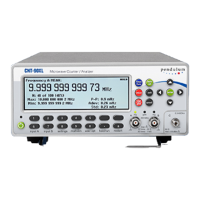This function is only accessible via GPIB or
USB.
No absolute time exists, timestamp values
can only be used for relative time
measurements.
Timestamps are taken of two consecutive
positive edges and two consecutive
negative edges (pos, neg, pos, neg or neg,
pos, neg, pos) and the number of positive
edges is counted.
All measuring functions can be auto-set
using best settings for the individual
functions. This means e.g. an auto hysteresis
of 40% of Vp-p in frequency measurements,
an auto trigger at 50% of Vp-p with
minimum hysteresis incl. hysteresis
compensation in time measure- ments, an
auto find of burst length and auto sync for
frequency burst measurements, etc.
NOTE: The frequency range for inputs A
& B, is up to 300 MHz for Auto trig,
and
up to 400 MHz for Manual trig
Specifications
Inputs A and B
Alternative data within parentheses refer to
input attenuator setting x10.
Frequency Range
DC-coupled:
AC-coupled:
Coupling:
Rise Time:
Impedance:
Trigger Slope:
Channels:
Max. Channel
Timing
Difference:
Hysteresis
Window:
Residual Hyster-
esis after Com-
p
ensation:
Sensitivity
DC - 200 MHz:
200 - 300 MHz:
3
00 - 400 MHz:
Auto Trig:
Attenuation:
Dynamic Range
(x1):
Trigger Level
Resolution:
Uncertainty:
DC - 400 MHz
10 Hz-400 MHz
AC or DC
Approx. 700 ps
1 M / 2 5 p F o r 5 0
(VSWR < 2)
Positive or negative
Separate A & B
15 mVrms
25 mVrms
35 mVrms
35 mVrms
x1, x10
30 mVp-p to 10 Vp-p within
±5 V window
Read-out on display
3 (30) mV
±15 (150) m V ± 1% of trigger
level
Automatically set to 50% of
input signal (10% and
90% for rise/fall time).
Relative level (in %) manually
adjustable when necessary.
Minimum hysteresis window
USER MANUAL ● CNT 9x Series ● Rev.22 February 2020

